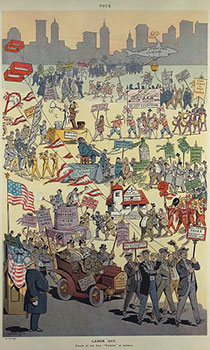Learn
Labor
For many people in the workforce, pay and benefits will be determined by the forces of supply and demand. Just as supply and demand determine the price of products, supply and demand determine the wages that workers receive, as well as the wages that suppliers must pay.
The first point to keep in mind is that the demand for labor is derived from the demand for the products that people buy.
- If you want to be paid well, make sure you have the skills to make the products people desire the most.
- For example, in this era you want to be a software engineer, instead of the best typewriter repairman in town.
Productivity
While the demand for labor is derived from the demand for a product, other influences factor into pay as well.
First of all, wages in this country have traditionally risen with productivity. However, as the chart below shows, beginning in the mid-1970s, rising productivity failed to result in commensurately rising wages for workers.

One example of this trend is farming.
- Farmers of today still work the same long hours as farmers of the past.
- However, since today's farmers are more productive (with better equipment, fertilizers, etc.), their income is greater.
Human Capital
Why is there such a vast difference in what people earn? Human capital is the key to higher pay.
- People with professional degrees, like doctors, lawyers, and accountants, make a huge investment in education. Professional occupations require years of study and a degree serves as proof that the recipient is qualified to practice that profession.
- This requirement serves as a barrier-to-entry, which limits the supply of eligible workers and raises salaries of qualified workers.
There is a direct correlation between level of education and earnings.
Also, in today's economy, there exists an inverse relationship between level of education and unemployment.
- A college degree, or other post-secondary education, seems to be the key to prosperity.
- See Employment Projections: Unemployment rates and earnings by educational attainment from the Bureau of Labor Statistics to see a chart of the relationships between level of education, unemployment rate, and earnings.
Skilled vs. Unskilled
One of the key factors of human capital is the difference between skilled and unskilled workers.
- Electricians, plumbers, mechanics, and other similar skilled workers usually complete some sort of internship or specialized training of specific skills before they are given licenses to perform work for customers. These skilled jobs, with their limited supply, will earn more than a job that requires very little skill or training.
- Many minimum wage fast food jobs, or service related jobs, require a minimal amount of training before workers can complete all tasks associated with the job.
A simple rule to remember is that the greater the supply of potential workers for a job, the less that job will pay.
Working Conditions
Another factor to consider in what people are paid is working conditions. Some jobs are very unpleasant, dangerous, or noisy. These compensating wage differentials are evident in jobs in steel mills, oil platforms in the ocean, crab fisherman in Alaska, or construction workers.
The rule of thumb is that, in order to attract people to jobs that will make them tired or dirty, risk injury, or be miserable in general, an employer will have to pay more. If you want to be clean, pleasant, and engage in friendly conversations with customers, you should expect to be paid less.
Discrimination
No discussion of wages is complete without a discussion of persistence of discrimination in the workplace. While many gains have been made with race relations over the last five or six decades, there is still evidence of at least some discrimination in the workplace. Read Racial and Ethnic Characteristics of the U.S. labor force, 2011 from the Bureau of Labor Statistics to learn more about how the labor force can be broken down by racial and ethnic characteristics, and how each group is performing in the current economy.
Trends
Now with a basic understanding of the labor market, read the following article to get a breakdown of the current employment trends among men, women, youth, races, and educational attainment. Read An Overview of Economic, Social, and Demographic Trends Affecting the U.S. Labor Market from The Urban Institute to learn more about the labor market. You will use this article to complete a task later in the lesson.
Labor Unions
No discussion of labor is complete without learning about the history of labor unions. With the industrialization in the country starting in the beginning of the 1800s, the paternal relationship between labor and management changed. Initially, all of the power in the relationship rested squarely with businesses.
With massive numbers of immigrants flooding the workforce and a government more interested in a growing economy, workers were not always treated with the respect they deserved and were mistreated. It took workers binding together to stand up to the power, money and influence of large businesses to improve their circumstances. Workers learned that there is strength in numbers. By uniting together, workers won concessions from businesses and helped define the relationship between an employer and an employee.
Labor Movement: Strikes and Tragedies Lead to Change
Next, you will learn about the significance of the Labor Movement in the United States. Let's review some strikes and tragedies that lead to change!
The Haymarket Square Strike
Workers from the McCormick Harvesting Company lead a strike in 1886 in Chicago's Haymarket Square. The workers were protesting against unfair labor practices and striking for an eight-hour work day. An unknown person threw a bomb at police, turning the peaceful labor protest into a riot. Seven police officers were killed during the strike, along with at least 4 protestors. This strike lead to the establishment of the Knights of Labor organization.
To learn more, read How a Bomb Tossed in 1886 Impacted the American Labor Movement from ThoughtCo.

Pullman Strike
Workers from the Pullman Palace Car Company lead a strike in 1884 against unfair labor practices. President Grover Cleveland sent federal troops to end the strike. Leader Eugene Debs was convicted and sentenced to prison for his involvement.
According to the editorial cartoon, what were the 2 central issues the workers were fighting against?
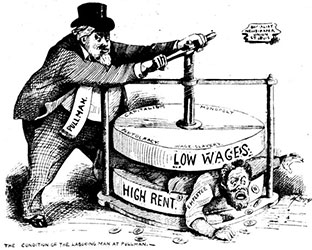
To learn more, read The Pullman Strike of 1894 from ThoughtCo.
The Homestead Strike
Pennsylvania workers from the Homestead Steel Works Plant – part of the Carnegie Steel Company owned by Andrew Carnegie – lead a strike in 1892 against unfair labor practices.
Pinkerton detectives Pinkerton detectives were part of the Pinkerton National Detective Agency, a private security guard and detective agency established in the United States in 1850. were hired to end the strike that involved the deaths of several workers.
To learn more, read The Homestead Steel Strike from ThoughtCo
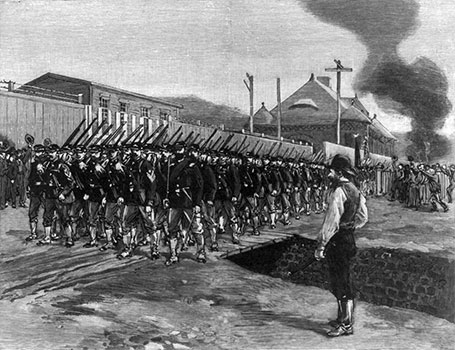
J.P. Morgan and the Coal Miners' Strike
Workers from J.P. Morgan's coal mines lead a strike in 1902 against unfair labor practices. They sought higher wages, shorter workdays, and recognition of the United Mine Workers of America union.
President Teddy Roosevelt negotiated with J.P. Morgan to end the strike.
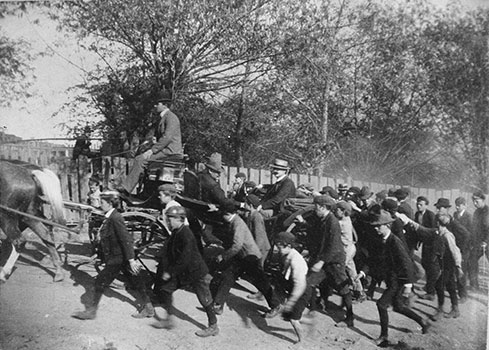
Triangle Shirtwaist Fire
146 workers in the Garment District of New York City died in a fire in 1911 at the Triangle Shirtwaist Factory. Most of those killed were women.
This tragedy lead to increased building code regulations to ensure worker safety.
To learn more, read Triangle Shirtwaist Factory Fire from ThoughtCo.
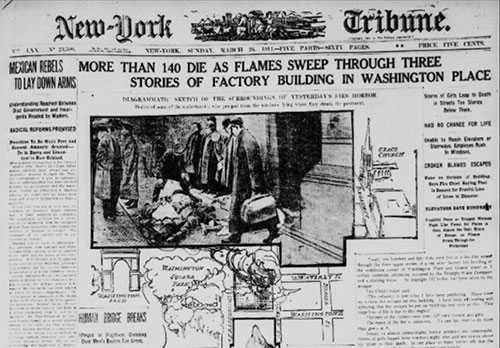
Organizations Established
Some key organizations in the Labor Movement:
- (CIO) Committee for Industrial Organizations: Formed in 1886 for skilled and unskilled workers. John L. Lewis was the founder.
- (AFL) American Federation of Labor: Formed in 1886 for skilled workers. Samuel Gompers was the founder.
- AFL-CIO: The AFL and CIO unions combined in 1955.
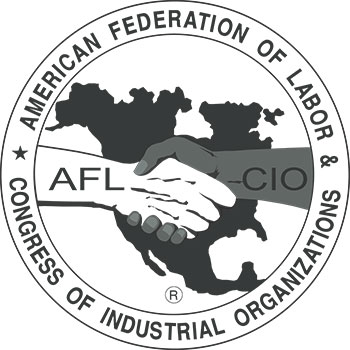
Legislation Enacted
The following are key pieces of legislation:
- Taft-Hartley Act: Became law in 1947, and banned closed shops a place of work where membership in a union is a condition for being hired and for continued employment , and stopped unions from donating to political campaigns.
- National Labor Relations Act (Wagner Act): Became law in 1935 and recognized the right of workers to organize a labor union.

Benefits for Workers
The following are benefits to workers gained through actions of the Labor Movement:
- Better work environments
- Higher pay
- Safer working conditions
- The right to collective bargaining
- The eight hour work day
- The end of child labor
- The five day workweek
- Benefits, which include pensions for retirement
- Healthcare
Celebration of Labor Day
The first Labor Day holiday was celebrated in New York City on September 5, 1882.
The United States Congress declared Labor Day a federal holiday on June 28, 1894.
Understanding the sacrifices made by many workers in the past should provide a greater appreciation for our nation's Labor Day celebration. Labor Day is observed on the first Monday of September. While many simply see Labor Day as a day off from work and an opportunity to cook-out and relax, people should take time to honor the sacrifices by those workers before us.
To learn more, read Labor Day Purpose and History from ThoughtCo.
